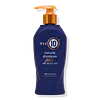What's inside
What's inside
 Key Ingredients
Key Ingredients

No key ingredients
 Benefits
Benefits

 Concerns
Concerns

 Ingredients Side-by-side
Ingredients Side-by-side

Cyclopentasiloxane
EmollientDimethiconol
EmollientHydrolyzed Keratin
HumectantPrunus Amygdalus Dulcis Oil
Skin ConditioningMauritia Flexuosa Fruit Oil
Skin ConditioningCinnamidopropyltrimonium Chloride
Argania Spinosa Kernel Oil
EmollientIsohexadecane
EmollientAlpha-Isomethyl Ionone
PerfumingPolysilicone-15
UV FilterKeratin Amino Acids
Skin ConditioningOenothera Biennis Oil
EmollientSesamum Indicum Seed Oil
EmollientParfum
MaskingLinalool
PerfumingHexyl Cinnamal
PerfumingButylphenyl Methylpropional
PerfumingHydroxyisohexyl 3-Cyclohexene Carboxaldehyde
MaskingCitronellol
PerfumingLimonene
PerfumingBenzyl Benzoate
AntimicrobialCyclopentasiloxane, Dimethiconol, Hydrolyzed Keratin, Prunus Amygdalus Dulcis Oil, Mauritia Flexuosa Fruit Oil, Cinnamidopropyltrimonium Chloride, Argania Spinosa Kernel Oil, Isohexadecane, Alpha-Isomethyl Ionone, Polysilicone-15, Keratin Amino Acids, Oenothera Biennis Oil, Sesamum Indicum Seed Oil, Parfum, Linalool, Hexyl Cinnamal, Butylphenyl Methylpropional, Hydroxyisohexyl 3-Cyclohexene Carboxaldehyde, Citronellol, Limonene, Benzyl Benzoate
Water
Skin ConditioningSodium Cocoyl Isethionate
CleansingDisodium Laureth Sulfosuccinate
CleansingSodium Lauryl Sulfoacetate
CleansingSodium Lauroyl Sarcosinate
CleansingCoco-Betaine
CleansingGlycol Distearate
EmollientGlycereth-26
HumectantDecyl Glucoside
CleansingCoconut Acid
CleansingSodium Hydroxide
BufferingParfum
MaskingSodium Isethionate
CleansingCitric Acid
BufferingPPG-5-Ceteth-20
EmulsifyingSodium Chloride
MaskingDivinyldimethicone/Dimethicone Copolymer
Polyquaternium-7
Amodimethicone
Polyquaternium-10
Carbomer
Emulsion StabilisingAcrylates Copolymer
PEG-55 Propylene Glycol Oleate
Propylene Glycol
HumectantC11-15 Pareth-7
EmulsifyingHexyl Cinnamal
PerfumingBenzoic Acid
MaskingLaureth-9
EmulsifyingButylene Glycol
HumectantGlycerin
HumectantLinalool
PerfumingTocopherol
AntioxidantOlea Europaea Fruit Oil
MaskingCamelina Sativa Seed Oil
Skin ConditioningTrideceth-12
EmulsifyingSalicylic Acid
MaskingHelianthus Annuus Seed Extract
Skin ConditioningSodium Benzoate
MaskingMagnesium Nitrate
Benzyl Alcohol
PerfumingC12-13 Pareth-23
CleansingC12-13 Pareth-3
EmulsifyingHydrolyzed Vegetable Protein Pg-Propyl Silanetriol
Skin ConditioningLimonene
PerfumingArginine
Masking2-Oleamido-1,3-Octadecanediol
Skin ConditioningPoly(Linseed Oil)
Benzophenone-4
UV AbsorberPhenoxyethanol
PreservativeCitronellol
PerfumingCI 14700
Cosmetic ColorantMethylchloroisothiazolinone
PreservativeSorbic Acid
PreservativeHaematococcus Pluvialis Extract
AntioxidantMagnesium Chloride
Methylisothiazolinone
PreservativeCaprylic/Capric Triglyceride
MaskingPotassium Sorbate
PreservativeCI 15510
Cosmetic ColorantWater, Sodium Cocoyl Isethionate, Disodium Laureth Sulfosuccinate, Sodium Lauryl Sulfoacetate, Sodium Lauroyl Sarcosinate, Coco-Betaine, Glycol Distearate, Glycereth-26, Decyl Glucoside, Coconut Acid, Sodium Hydroxide, Parfum, Sodium Isethionate, Citric Acid, PPG-5-Ceteth-20, Sodium Chloride, Divinyldimethicone/Dimethicone Copolymer, Polyquaternium-7, Amodimethicone, Polyquaternium-10, Carbomer, Acrylates Copolymer, PEG-55 Propylene Glycol Oleate, Propylene Glycol, C11-15 Pareth-7, Hexyl Cinnamal, Benzoic Acid, Laureth-9, Butylene Glycol, Glycerin, Linalool, Tocopherol, Olea Europaea Fruit Oil, Camelina Sativa Seed Oil, Trideceth-12, Salicylic Acid, Helianthus Annuus Seed Extract, Sodium Benzoate, Magnesium Nitrate, Benzyl Alcohol, C12-13 Pareth-23, C12-13 Pareth-3, Hydrolyzed Vegetable Protein Pg-Propyl Silanetriol, Limonene, Arginine, 2-Oleamido-1,3-Octadecanediol, Poly(Linseed Oil), Benzophenone-4, Phenoxyethanol, Citronellol, CI 14700, Methylchloroisothiazolinone, Sorbic Acid, Haematococcus Pluvialis Extract, Magnesium Chloride, Methylisothiazolinone, Caprylic/Capric Triglyceride, Potassium Sorbate, CI 15510
 Reviews
Reviews

Alternatives
Ingredients Explained
These ingredients are found in both products.
Ingredients higher up in an ingredient list are typically present in a larger amount.
Citronellol is used to add fragrance/parfum to a product. It is often derived from plants such as roses. In fact, it can be found in many essential oils including geranium, lavender, neroli, and more. The scent of Citronellol is often described as "fresh, grassy, and citrus-like".
Since the Citronellol molecule is already unstable, Citronellol becomes irritating on the skin when exposed to air.
Citronellol is a modified terpene. Terpenes are unsaturated hydrocarbons found in plants. They make up the primary part of essential oils.
Citronellol is not able to be absorbed into deeper layers of the skin. It has low permeability,
Citronellol is also a natural insect repellent.
Learn more about CitronellolHexyl Cinnamal is a fragrance ingredient with a similar scent to jasmine. It can be naturally found in chamomile essential oil.
This ingredient is a known EU allergen and may sensitize the skin. The EU requires this ingredient to be listed separately on an ingredients list.
Hexyl Cinnamal is not water soluble but is soluble in oils.
Learn more about Hexyl CinnamalLimonene is a fragrance that adds scent and taste to a formulation.
It's found in the peel oil of citrus fruits and other plants such as lavender and eucalyptus. The scent of limonene is generally described as "sweet citrus".
Limonene acts as an antioxidant, meaning it helps neutralize free radicals.
When exposed to air, oxidized limonene may sensitize the skin. Because of this, limonene is often avoided by people with sensitive skin.
The term 'fragrance' is not regulated in many countries. In many cases, it is up to the brand to define this term. For instance, many brands choose to label themselves as "fragrance-free" because they are not using synthetic fragrances. However, their products may still contain ingredients such as essential oils that are considered a fragrance.
Learn more about LimoneneLinalool is a fragrance and helps add scent to products. It's derived from common plants such as cinnamon, mint, citrus, and lavender.
Like Limonene, this ingredient oxidizes when exposed to air. Oxidized linalool can cause allergies and skin sensitivity.
This ingredient has a scent that is floral, spicy tropical, and citrus-like.
Learn more about LinaloolParfum is a catch-all term for an ingredient or more that is used to give a scent to products.
Also called "fragrance", this ingredient can be a blend of hundreds of chemicals or plant oils. This means every product with "fragrance" or "parfum" in the ingredients list is a different mixture.
For instance, Habanolide is a proprietary trade name for a specific aroma chemical. When used as a fragrance ingredient in cosmetics, most aroma chemicals fall under the broad labeling category of “FRAGRANCE” or “PARFUM” according to EU and US regulations.
The term 'parfum' or 'fragrance' is not regulated in many countries. In many cases, it is up to the brand to define this term.
For instance, many brands choose to label themselves as "fragrance-free" because they are not using synthetic fragrances. However, their products may still contain ingredients such as essential oils that are considered a fragrance by INCI standards.
One example is Calendula flower extract. Calendula is an essential oil that still imparts a scent or 'fragrance'.
Depending on the blend, the ingredients in the mixture can cause allergies and sensitivities on the skin. Some ingredients that are known EU allergens include linalool and citronellol.
Parfum can also be used to mask or cover an unpleasant scent.
The bottom line is: not all fragrances/parfum/ingredients are created equally. If you are worried about fragrances, we recommend taking a closer look at an ingredient. And of course, we always recommend speaking with a professional.
Learn more about Parfum